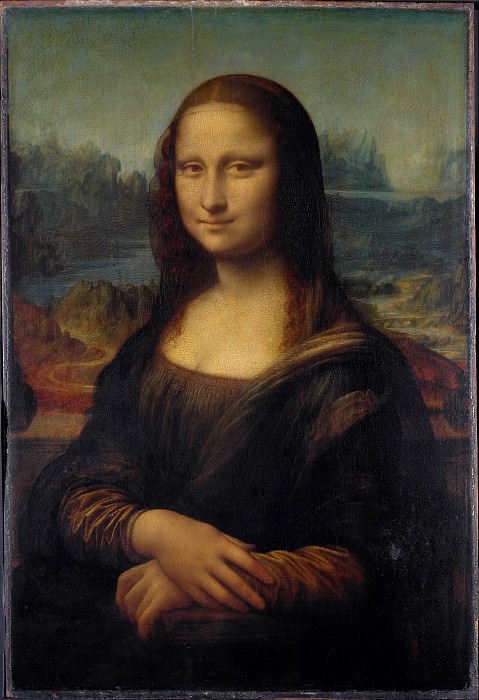Two versions of Mona Lisa could be created in Florence in parallel  Automatic translate
Automatic translate
In the spring of 1503, a wealthy Florentine silk merchant Francesco del Giocondo commissioned a portrait of his wife Lisa Gerardini from the artist Leonardo da Vinci. This happened on the occasion of the birth of their son and the appearance of their own household. The contract was significant because almost all of Florence knew about this, as evidenced by the accidentally discovered in 2005, a record of Cicero’s letters in incunabula, located at the University Library in Heidelberg.
The book from Heidelberg at the beginning of the 16th century belonged to Chancellor of Florence Agostino Vespucci and he wrote down his notes on the edge of the printed text. In the section where Cicero describes how the ancient artist Orange in the Venus painting impressively portrayed his head and bust, leaving the other parts unfinished, Vespucci noted in October 1503 that “Leonardo does this in all his paintings, for example at the head of Lisa del Giocondo or Anne of the Virgin. ”
Vespucci was supposed to see the portrait of Mona Lisa with his own eyes. The second one, who was definitely supposed to see and admire her in Florence, was young artist Raphael who made a great career at the Papal court in Rome. In the Paris Louvre in 1504, he had a preparatory drawing for a portrait that would never have been made without a detailed knowledge of Leonardo’s painting.
But what did Vespucci’s secretary and artist Raphael actually see? There are two almost identical portraits that arose in Florence at the beginning of the 16th century. One is in Louvre Museum in Paris , another in Prado in Madrid And both of them were painted in the workshop of Leonardo.
The painting from the Prado in Madrid has long been considered by experts as a simple copy-imitation of "Mona Lisa" from Paris. There are many such quality old copies, for example, in the art museums of Liverpool, Baltimore, St. Petersburg or Oslo. Artists simply reproduced the finished masterpiece.
However, the restoration and exploration of Mona Lisa from Spain has yielded exciting results. The painting was painted on a walnut wood plank, a material that Leonardo used in other portraits, such as "Lady with an Ermine" from Krakow or so-called “La Belle Ferroniere” (The Beautiful Ferronier) from Paris The entire board was coated with a primer, which was used only and exclusively in Leonardo’s studio, which was confirmed by an analysis of the chemical composition.
However, the most surprising discovery was the so-called infrared reflector, with which you can carefully study all the refinements and changes that the artist made in the picture before finishing it. And this question clearly showed that when the artist in the painting from the Louvre decided to change the shape of the sleeve, the author did the same immediately in the second work from Prado. So Mona Lisa from Prado is not a copy of the finished model - obviously, it was written in parallel with the "Mona Lisa" from the Louvre. It can be assumed that a second artist worked in the Florentine studio of Leonardo, who observed his teacher.
This fact is also known from the scriptures of the time. In a letter to the Duchess Isabella d’Este Pietro de Novellara talks about his visit to Leonardo and mentions that he saw students watching the faithful imitation of the master’s paintings. And "Mona Lisa" was no exception.
Experts suggest that one of the artists of these parallel paintings could be the beloved Leonardo Salai. The student and, subsequently, apprentice was Gian Giacomo Caprotti. At the age of 10, he went to study with Leonardo in 1490 and never left his teacher. He accompanied him everywhere and was infinitely devoted to him. He never signed his work. His ambition was to imitate Leonardo as much as possible. When Leonardo died in France, he bequeathed to Caprotti all his paintings, which Salai then sold to the king of France. Including the "Mona Lisa", which Leonardo brought from Italy to France.
The question remains why the two "Mona Lisa" were created in the workshop of Leonardo. The restorers helped again in several possible ways. They found that in both paintings, both from the Louvre and from Prado, the best materials for painting were used, which suggests that the second “Mona Lisa” was not just the educational work of a student trying to learn the secrets of his teacher’s work. Leonardo had expected from the very beginning that there would be two of them. Both one and the other will be of the highest quality in terms of technology. But why?
The answer must begin with the preposition "o". We don’t know anything for sure. However, it is known about Leonardo that he worked for a very long time and slowly. He never considered something completely finished, he continued to correct his paintings and look for perfect beauty. Customers were desperate about this and demanded the transfer of the order. Thus, it is likely that when Mr. Francesco del Giocondo came for a portrait of his wife, they gave him a painting that was actually secretly and from the very beginning painted by his devout aide.
Leonardo was left with the original and he could play with him without interference for many years, so the result was exactly what he imagined. But perhaps there is another explanation. Unfortunately, there is very little historical evidence. Much remains a mystery, and in the case of Leonardo da Vinci, this mystery is neither the first nor the last. The fact remains that the two Mona Lisa paintings, both created in Leonardo’s studio, are now in the French Louvre and the Prado Museum in Madrid. The first is a miracle of art, the second is its shadow.

